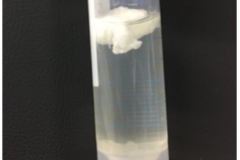
Life is happening in confined spaces
Cells are the unities of life. Cells are three dimensional units formed by a membrane and functional organelles imbedded in a cytoplasm where water is the main component. In every cell thousands of chemical and biochemical reactions are taking place simultaneously in confined spaces. The kinetics of these reactions depend not only on concentration of reactants and catalysts but also on their location and spatial accessibility, i.e. they are topochemical reactions.
A topochemical reaction is one in which both the nature and properties of the products of the reaction are governed by the three-dimensional topological environment of molecules or atoms. Photochemical reactions in organic crystals are examples of topochemical reactions that have been extensively studied by organic chemists. Irving Langmuir also first noted the kinetic consequences of reaction zones in a topological space (i.e., the rate of a topochemical reaction is not proportional to the total amount of unreacted material but rather to the amount of material present in the reaction zone).
Cells, tissues and organs and organisms are topological spaces and a deep understanding of topochemical bioassembly present in nature is highly needed. This bioassembly is energy efficient, waste-free and tailored via evolution of cells in a timeline of millions of years. The topochemical bioassembly present in nature is combination of topochemical assembly and topochemical disassembly.
Topochemical engineering and biofabrication
The field of topochemistry is fascinating, and different definitions of topochemical reactions have been suggested. However, the relevance of topochemistry has been overlooked in many scientific fields and sometimes even confused with surface engineering or supramolecular chemistry. Reactions in three-dimensional confined spaces are extremely relevant to cell metabolism, protein biosynthesis, and numerous biological interactions and materials. Topochemistry influences the structure–function relationship of natural and man-made systems and therefore plays a key role in biofabrication.
Topochemical engineering is a method of directed assembly or directed disassembly of functional materials. Directed assembly and disassembly are controlled via the design of molecular and intermolecular interactions in a topological space. The directed assembly uses electrostatic interactions, hydrogen bonding, hydrophobic interactions, or solid-state cross-linking reactions of components to create functional shapes and interfaces. The directed disassembly of a component from a multicomponent system is designed on the basis of the controlled cleavage of molecular and intermolecular bonds and the formation of new molecular and intermolecular interactions that enhance separation and selected fractionation.
Topochemical engineering combined with biofabrication is a unique strategy to boost the advance of sustainable technologies. The topochemical bioassembly present on trees and other natural systems can used as inspiration.
The long life of the trees as inspiration for biofabrication
Trees can live hundreds or even thousands of years. They are able to endure and survive the most hostile conditions using a very sophisticate system of defense and stimuli-responsive interaction with their environments. The tree biosynthesizes more than five thousand chemicals including complex polymeric systems with structural function such as cellulose, hemicelluloses, lignins and a multitude of non-structural components such as terpenoids, fats, polyphenols, water soluble carbohydrates and inorganics. The biosynthetic processes occur in water and in confined spaces being combined with assembly of highly engineered nanostructures. It is a process of topochemical engineering of a stimuli-responsive material that has been mastered through thousand years of evolution.
Bioactive substances from wood have been used in health improvement for more than 9000 years. Pine tar has been used in treatment of skin diseases such as psoriasis, eczema and rosacea and also as natural antiseptic germicidal. Pine oleoresin was used already 1700 years ago as medicine against ulcers and sores in China. Modern science and technology are plenty of applications of wood components in health and care. Sterols have been used in functional foods to reduce cholesterol and heart disease in humans and also as additives in cosmetics. Leaf extracts of Ginkgo biloba has been clinically prescribed to treat disorders of the central nervous systems such as Alzheimer disease. In the pharmaceutical industry, two largely used drugs, the pain killer Aspirin and the ovarian and breast cancer chemotherapeutic Taxol, were developed based on extracts of bark of Salix spp. and Taxus brevifolia, respectively.
Taxol is the best-selling cancer drug ever manufactured and it is currently biofabricated using bioreactors. More recently lignans from spruce knots have been reported to inhibit growth of breast, prostate and colon cancer and also to help to maintain good cardiovascular health and to moderate other estrogen-dependent health problems such as menopause symptoms and osteoporosis. Larch arabinogalactans and galactoglucomannans were reported to improve immune response and digestive health while xylitol has been frequently used to enhance dental health. The list of successful applications of wood components in health and care is vast but is still the tip of the iceberg. There is an enormous potential to exploit thousands of wood components to create analogues for therapies of challenging diseases that will be demanded for a crescent aging population. Trees can be used as source of bioactive components or inspiration for chemical analogues for new pharmaceuticals, agrochemicals, additives in functional foods, cosmetics and personal care. Wood structural components such as cellulose and hemicelluloses and their hybrids with proteins and synthetic polymers can be used for creation of advanced materials for tissue engineering and carriers of pharmaceuticals, functional food additives, substrates for personal care and many others. The combination of tree components with stimuli-responsive synthetic polymers, nanosegments and inorganic particles can create a multitude of unique hybrid materials for advanced application in healthcare.













